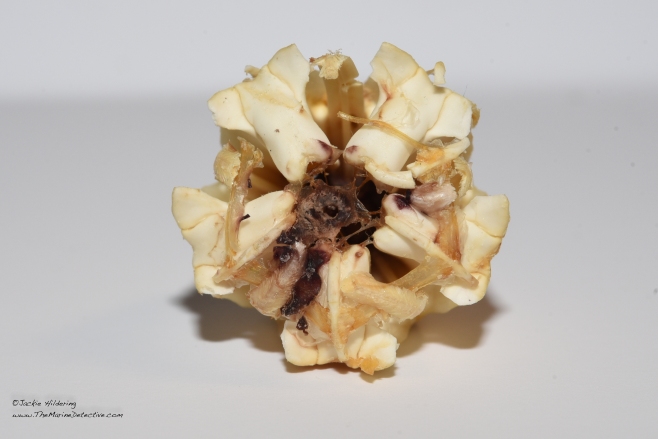Aristotle’s Lantern
What is so thought-provoking that it warrants the name “Aristotle’s Lantern”? It’s what the mouth-parts of urchins are called.
Today while I was submerging, there was a dead Green Urchin floating at the surface, spines rotted off but mouth still intact.
This allowed me to photograph the jaw parts outside the urchin’s shell (test).


Close-up on the dead Green Urchin’s underside with the mouthparts.
This is something I would not normally be able to photograph because I would have to lift an urchin to do so and I do not want displace the life I see. Also, because most dead urchins I find floating about have been “otterized”. An otterized urchin is where a predator has broken through the bottom of the urchin. Mammalian predators of urchins include River Otters, Sea Otters, Mink and humans. Wolf-Eels and Sunflower Stars are also predators. Another reason the mouth parts are difficult to photograph is because they can retract into the urchin when alive.
The photos included below of the full mouth structure are from another dead urchin whose “Lantern” I preserved. See how complex it is? There are 5 jaws made from plates of calcium, which are held together by muscle. When wanting to chew away at seaweed / algae, the structure is pushed out whereby the mouth opens and the urchin can chew by moving the structure side-to-side. You can imagine that chewing would wear down the calcium but no worries – the Lantern grows from the tip, reportedly at 1 to 2 mm / week.



Why are an urchin’s mouthparts called “Aristotle’s Lantern”? Because Aristotle is believe to have described them as “lantern-like” in Historia Animalium (The History of Animals) more than 2,340 years ago.
Indeed, the “horn lanterns” used in Aristotle’s time looked like the mouthparts; having 5 panes covered with cow horn that had been boiled and shaped. BUT there are biologists who disagree, believing that there were “historical ambiguities with the original translation” and that Aristotle was referencing the WHOLE urchin’s shell as being lantern-like, rather than just the mouthparts.
Oops – if that be true, Aristotle would not be happy that the mouthparts of urchins’ near relatives, sand dollars, are also referenced as “Aristotle’s Lanterns”.
There don’t you feel better now knowing all of this? I am here striving to lighten and enlighten . . . lanterns and all. 💙☺️💙

Dive buddy Natasha Dickinson having but an urchin test over her dive light. Sure looks like a lantern doesn’t it? 🙂
Here’s a “Shape of Life” video of urchins feeding, narrated to be oh so dramatic:
About regeneration, aging and life expectancy in sea urchins
Like sea stars and other echinoderms, urchins can regenerate body parts e.g. their spines and tube feet. Research by Bodnar and Coffman (2016) found that this ability to regenerate lost or damaged tissues does not decrease with age in 3 local urchins species: the Variegated Urchin (Lytechinus variegatus), Purple Urchin (Strongylocentrotus purpuratus) and Red Urchin (Mesocentrotus franciscanus).
This is of particular interest since the life expectancy of these three urchin species is very different; respectively 4 years, 50+ years, and 100+ years. Yet, “the fact that all species showed the same consistent ability to regenerate tissue despite age and life expectancy undermines the current evolutionary theories of ageing. It was previously expected that species with shorter lifespans would invest fewer resources in maintenance and repair, perhaps to invest greater energy in reproduction. So this study has shed light on a new, unexpected factor that contradicts the current theory.” Source: Biosphere.
Regarding the life expectancy of Green Urchins (Strongylocentrotus droebachiensis) from Fisheries and Oceans Canada: “Aging techniques for B.C. Green Urchins are currently being developed by the Pacific Biological Station, but Green Urchins on the Atlantic Coast have been known to live from 20 to 25 years of age.”
See below for images of urchins feeding and of “urchin barrens” . Urchins are an important part of the marine ecosystem but when we killed off Sea Otters who eat urchins, this led to too much kelp being eaten. The resulting “urchin barrens” are a loss of habitat and food for other organisms and result is less carbon buffering and oxygen production by kelp.
Sea Star Wasting Disease, and specifically the devastation to Sunflower Stars (Pycnopodia helianthoides), has also led to urchin barrens because Sunflower Stars too are predators of urchins. For more information, see my blog “Wasted. What is happening to the sea stars of the NE Pacific Ocean?





Sources:
- Bodnar AG, Coffman JA. Maintenance of somatic tissue regeneration with age in short- and long-lived species of sea urchins. Aging Cell. 2016;15(4):778-787. doi:10.1111/acel.12487
- Mount Desert Island Biological Laboratory. “Is aging inevitable? Not necessarily for sea urchins: Study shows that sea urchins defy aging, regardless of lifespan.” ScienceDaily. ScienceDaily, 25 May 2016.


4 Responses to “Aristotle’s Lantern”
Dear Jackie,
Thank you for once again sharing your observations,novel and fascinating to me, in words and photographs. So many things happening under/in the ocean yet often unconsidered by humankind while we remain caught up in daily routines. I believe (hope) COVID19 is bringing more people to awareness/appreciation of the wonders of this world with help from people like you. Fascination with nature can easily be overshadowed by despair at the sight of so much harm done to the web of life. Your continued sharing of that deep cold amazing world you dive in ……and especially the last two paragraphs of your recent poetic offering…..renew my hope.
In gratitude for all you do and are
Your words motivate and help lift me away from the despair B.P.
Thank you.
Jackie – Fascinating! Each time I read something written by you, I dive with a new perspective. And keep a keen eye out for something I may have merely glanced at in the past. Thank you!
I appreciate this feedback so much. It adds to my motivation to keep at it.